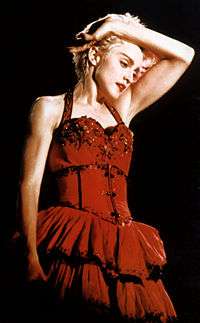Pop icon
A pop icon is a celebrity, character or object whose exposure in popular culture is regarded as constituting a defining characteristic of a given society or era. The usage of the term is largely subjective since there are no definitively objective criteria. The categorization is usually associated with elements such as longevity, ubiquity and distinction. Moreover, "pop icon" status is distinguishable from other kinds of notoriety outside pop culture, such as with historic figures. Some historic figures are recognized as having reached "pop icon" status during their era, and such status may continue into the present. Pop icons of previous eras include Benjamin Franklin[1] and Mozart.[2]
Longevity
Usually, the pop icon status of a celebrity is contingent upon longevity of notoriety.[3][4] This is in contrast to cult icons, whose notoriety or recognition may be limited to a specific subculture. Some pop icons have left a lasting and indelible mark in the area of their career, and then went on to attain a lasting place of recognition in society at large.[5]
Ubiquity
A common element of pop icon status is the ubiquity of imagery and allusions to the iconic figure.[note 1] It is common for the figure to be recognized and even celebrated in areas outside the original source of celebrity status.[note 2] An example of this is Albert Einstein, a physicist whose image and legacy have been represented in comic strips, T-shirts, greeting cards and many other contexts.[6]
Distinction
Often pop icon status implies distinguished association with a societal ideal or archetype. It is not uncommon for iconic figures to have a nickname or sobriquet that is used to emphasize this association. Sometimes the very name of such individuals is even used as a synonym for common words or ideas.
Some pop icons, such as Mickey Mouse,[7][7] Superman, Spider-Man, Batman, Darth Vader, Harry Potter,[8] the Simpsons,[7] SpongeBob SquarePants and even Sherlock Holmes are fictional characters. Even inanimate objects have been recognized as pop icons.[9][10][11]
Some figures attain transitory or context-specific "pop icon" status for particular events that captivate public attention, such as in the case of the O.J. Simpson trial.[12]
References
- Chaplin, Joyce (2006). The First Scientific American: Benjamin Franklin and the Pursuit of Genius. Basic Books. ISBN 0-465-00955-7.
- Nettl, Bruno (1995). Heartland Excursions: Ethnomusicological Reflections on Schools of Music. University of Illinois Press. ISBN 0-252-06468-2.
- Dearborn, Mary V. (December 9, 1999). Mailer: A Biography. Houghton Mifflin Books. ISBN 978-0-395-73655-5.
- Gottesman, Ronald; Brown, Richard Maxwell, eds. (1999). Violence in America: An Encyclopedia. Simon and Schuster. ISBN 0-684-80487-5.
- Ratcliff, Ben (November 6, 2002). The New York Times Essential Library: Jazz: A Critic's Guide to the 100 Most Important Recordings. Times Books. ISBN 978-0-8050-7068-2.
- Kaku, Michio (April 2004). Einstein's Cosmos: How Albert Einstein's Vision Transformed Our Understanding of Space and Time. W. W. Norton & Company. ISBN 978-0-393-05165-0.
- McNary, Dave (2011). "Icons of the century". Variety100.com. Variety. Archived from the original on August 15, 2011. Retrieved February 8, 2010.
- Schmidt, Robert (February 24, 2004). "The 200 Greatest Pop Culture Icons". Blue Corn Comics website. Retrieved February 8, 2010.
- Vail, Mark (April 1, 2002). The Hammond Organ: Beauty in the B (2nd ed.). Backbeat Books. ISBN 978-0-87930-705-9.
- Sheff, David (April 27, 1993). Game Over: How Nintendo Zapped an American Industry, Captured Your Dollars, and Enslaved Your Children. Random House. ISBN 978-0-679-40469-9.
- "The Liberty Bell: From Obscurity to Icon". Teaching with Historic Places. National Park Service. October 16, 2006.
- Boot, Max (1998). Out of Order: Arrogance, Corruption and Incompetence on the Bench. Basic Books. ISBN 978-0-465-05375-9.
Further reading
- Danesi, Marcel (2007). Popular Culture: Introductory Perspectives. Rowman & Littlefield. pp. 112–115. ISBN 0-7425-5547-X.
- Cullen, Jim, ed (2001). Popular Culture in American History. UK: Blackwell Publishing. ISBN 0-631-21958-7.

